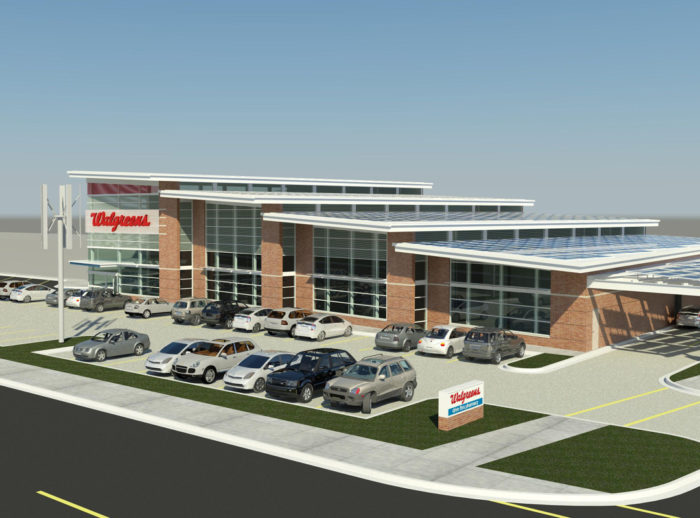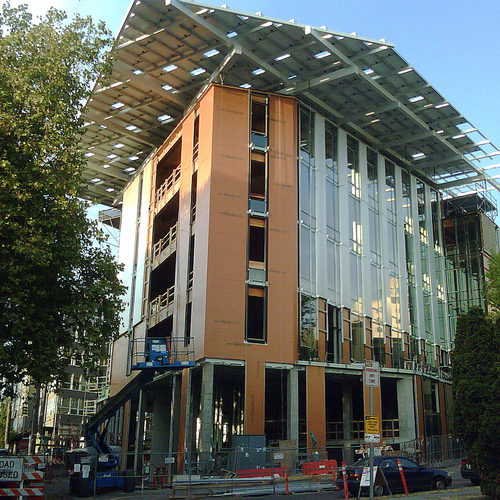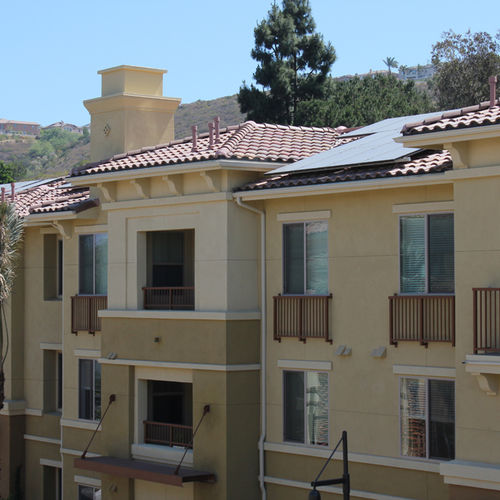Image Credit: Walgreens
Image Credit: Walgreens This screen shot from Google Maps shows the existing Walgreens drugstore in Evanston that will be razed to make room for a new net-zero energy store.
Image Credit: Google Maps
If you were thinking the nation’s first net-zero energy retail store might turn out to be something trendy, like an Apple store or a Starbucks, brace yourself. Those honors will apparently go to Walgreens, the national drugstore chain.
The company has announced that as far as it can tell its retail store in Evanston, Illinois, will be the first retail outlet in the U.S. to generate as much energy as it uses over the course of a year, thus meeting the “net-zero energy” test. Evanston is on the western shore of Lake Michigan just north of Chicago and not far from Walgreens headquarters in Deerfield.
“We’ve done some exhaustive research as you can imagine to find another retailer that has done this and we haven’t been able to find one,” says Jamie Meyers, Walgreens’ manager of sustainability. “That’s not to say there isn’t one out there but we’re fairly confident that if anyone had done this they would have spoken up about it because it’s a pretty difficult task particularly for a retailer.”
An existing Walgreens store is being torn down to make room for the net-zero building at the corner of Chicago Avenue and Keeney Street. Its proximity to company headquarters will make it convenient for Walgreens engineers to stop by and measure building performance over the year.
Meyers says the 13,968-sq. ft. drug store should be open for business by November. Walgreens won’t disclose how much the building will cost, but admits it will cost more than a typical outlet.
Rooftop PV, wind turbines and LED lighting
Walgreens estimates the building will actually be on the plus side of the energy ledger, generating 256,000 kWh of electricity a year while using 200,000 kWh.
Like any net-zero building, the new drugstore will get to net-zero performance with a combination of lower than average energy consumption and renewable energy systems.
Here are the details:
- Roughly 850 rooftop photovoltaic panels, with a total generating capacity of 225 kW.
- Two vertical-axis wind turbines, with a capacity of 6 kW.
- A ground-source heat pump using eight 550-foot deep wells below the store as its earth link.
- LED lighting.
- Carbon dioxide refrigeration equipment.
Not a typical net-zero strategy
Because of the cost of renewable energy systems and the space required to deploy them, residential net-zero projects tend to be super-insulated buildings with very low heating, cooling and electrical loads. Wall R-values of 40 and roofs insulated to R-60 aren’t uncommon.
“I can tell you we’re nowhere near that,” says Meyers. “We found through the energy model that once you get to a certain point it’s a case of diminishing returns.”
Designers did cut energy consumption in a variety of ways, but the nature of a retail store is completely different than a house where only a few people live. The whole point is to get people in and out of the building to shop, not button the building up tightly to reduce heating and cooling demands. Doors are opened and closed many times a day.
Meyers says the building has typical block and brick walls and an insulated metal deck roof. Although air sealing and insulation levels are relatively modest, the project makes up for it with its oversized renewable energy package. The rated 225 kW capacity of the PV panels is 20 times as much as a typical net-zero energy house.
Suppliers for the project include Trane, Cree lighting, Acuity Lighting, CalStar Products, Cooper Lighting, Geothermal International, and SoCore Energy. Energy modeling was done by Cyclone Energy Group of Chicago and the Energy Center of Wisconsin.
In addition to shooting for net-zero performance, Walgreens wants the building to win LEED’s top tier platinum rating and will enter it in the International Living Future Institute’s Living Building Challenge. The company also is partnered with the U.S. Department of Energy’s Better Buildings Challenge and committed to cut energy consumption by 20% by 2020.
The net-zero project is far from Walgreens’ first foray into energy efficient design. The company says 150 of its stores have solar power, two have been LEED-gold certified, and 400 have charging stations for electric vehicles.
“We want, as a company, to help people get, stay and live well,” Meyers says, “and part of living well is minimizing our impact on the environment, and so we have an opportunity with having 8,000 locations to have an impact. It’s important to us.”
If you have a Facebook account, you can read more about the project here.
Weekly Newsletter
Get building science and energy efficiency advice, plus special offers, in your inbox.
















9 Comments
first US dispenser ....
Here a first USA dispenser running on a net-zero energy supply:
http://www.wellpromo.com/wholesale-Logo-imprinted/Candy-Machines.htm
The continental type:
http://www.ipernity.com/doc/lichtundschatten/418568
Here a serious net-zero dispenser from Europe:
http://www.maxburgers.com/
All the anti-biotics and hormons, net zero ....certified. Not just the structure, the products as well.
Kinetic art
"Two vertical-axis wind turbines, with a capacity of 6 kW." - really? If anyone has any example of an urban VAWT performing anywhere near spec, I'd love to see it. This kind of thing makes me think they haven't done their research, to be honest.
Response to Hein Bloed
Hein,
Gumball dispensers and hamburgers? I don't get your point, Hein.
Response to Eric Sandeen
Eric,
Yes, those two rotating doo-dads amount to kinetic art (and an investment in marketing). Lots of architects and developers evidently feel the investment in such art is worth it, because it makes a project look green.
I imagine that each turbine has a maximum rating of 3 kW. That's not too unusual -- these ratings are calculated (usually) for a high wind speed like 28 mph -- a wind speed that is rarely reached.
net-zero
Sorry, I should have elaborated further:
( MH: " Gumball dispensers and hamburgers? I don't get your point, ")
The structure/building in itself has a very small impact on energy consumption/primary energy usage compared to the overall bill.
Which includes the infrastructure as well, the products sold and the profits made to justify the building's existence and maintenance.
The gumball dispenser I used as a sample of a 'retail unit' needing little maintenance and little initial energy input. A mobile unit, if clients don't turn up it will follow them.
The Swedish hamburger chain on the other hand (max.se) include a certain percentage in the price of their products for off-setting the energy consumption/CO2 emissions of the entire chain including the products.
( http://max.se/sv/Maten/Klimatdeklaration/ )
With the newer shops they're opening even an electric charging station is included for the vehicles of their clients.
The wind energy they consume is derived from large wind generators to be efficient.
The entire energy consumption chain is monitored, meassured and balanced.
Certified by independant analysts.
See also here:
http://www.maxburgers.com/sustainability/
So a drug store being net-zero would have to off-set not only the structure/building but the products it is selling as well.
Otherwise we might see net-zero oil wells soon be advertised by the Koch brothers :)
PS
Max is looking for franchisers, partners .....
Wind speeds
Being ~12 blocks from Lake Michigan, I can see them experiencing 28 mph winds (and greater), but not every hour of the day, every day of the year.
In the past, Walgreens has been very thorough on researching each store's location, studying socio-economic demographics in great detail. (Got a chance to hear their CEO speak 15 years ago, and it was eye-opening.)
While I would hope they conducted a wind study, I can certainly think of a lot worse places to locate wind turbines.
Urban wind
You can find thousands of online monitoring sites for urban solar (here's mine) but very very few for urban wind. It's almost like the manufacturers would rather you not know how they perform. I'm all for wind as an energy source, but like anything, you have to use the right technology in the right application. From the City of Reno to the Boston Museum of Science, most demonstrations of urban wind have been pretty dismal. Maybe putting them in front of the store is good marketing, but I might claim false advertising. Sorry if I sound like a grump. :)
I'm with the grump
I like the 225 kW PV. We need more retailers exploiting their flat, unshaded roofs for larger PV arrays. Half or more of the cost per Watt of residential scale kW can be avoided by economies of scale available to mid sized retailers and owners of similar low flat roofed buildings away from shade.
I agree that the pair of vertical axis wind turbines are strictly window dressing. That they are mounted at or below roof level of the host and surrounding buildings will nearly completely sabotage their performance as well as subject them to early failure ans their bearing must constantly bear the forces of turbulence caused by nearby buildings.
Kinetic art...that's about all they'll be good for, trending toward static art as their bearings give up and freeze.
I live in Evanston...
I am an architect in Evanston that got to take a look at the project during the review stage (very late in the review stage, I should point out). I think the general thought that the mini wind turbines are for show is quite correct. I am also involved in an offshore wind park concept off of the Evanston coast and we gently tried to get them to not put the small scale wind turbines up as they would very likely blur/confuse the very real difference between the tiny residential scale turbines and the huge output that the offshore turbines would produce. We are hoping that the wind offshore will be in the low 20 - 22 mph range, but on land, it is certainly much less than that.
I had done a simple analysis of residential scale wind turbines from another project. The turbines were 'rated' at 1kWh in 32 mph wind. The problem is, of course, no one has 32 mph average wind. Because wind power goes to the cube of wind speed, at 16 mph wind it would produce 125w. No one around here has 16 mph wind, and where the turbines were located, it was more like 8 mph. 8 mph wind would produce 15w of power, equal to one compact fluorescent bulb.
Having said all of that, the entire roof is covered in PV's and that is were 'all' of their production is coming from. I have to give them credit for trying this, and they will get quite good power production out of them. Walgreens is very committed to PV's and car charging stations. You tend to see charging stations at nearly all of their stores, at least in the Chicago area.
I did try to give them some commentary on their west facing glass, and even their south facing glass. They were saying they were thinking they were going to be getting some solar gain in the winter from them, but frankly, with that building type, the very high ceilings and the west facing glass, the solar gain requires more control than that.
Log in or create an account to post a comment.
Sign up Log in